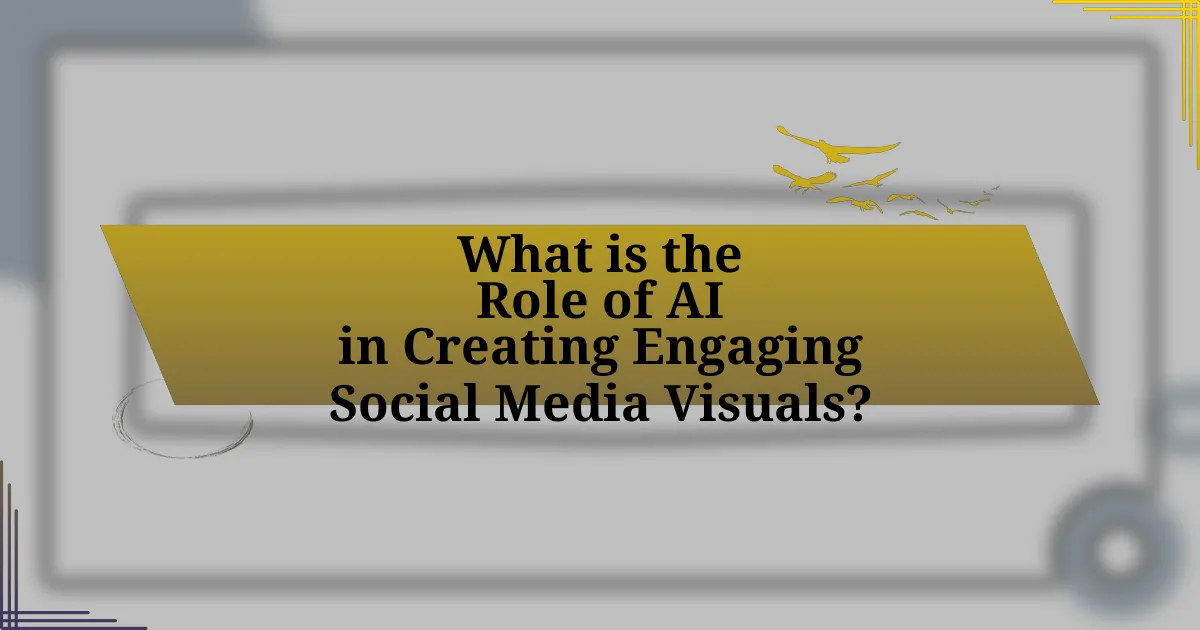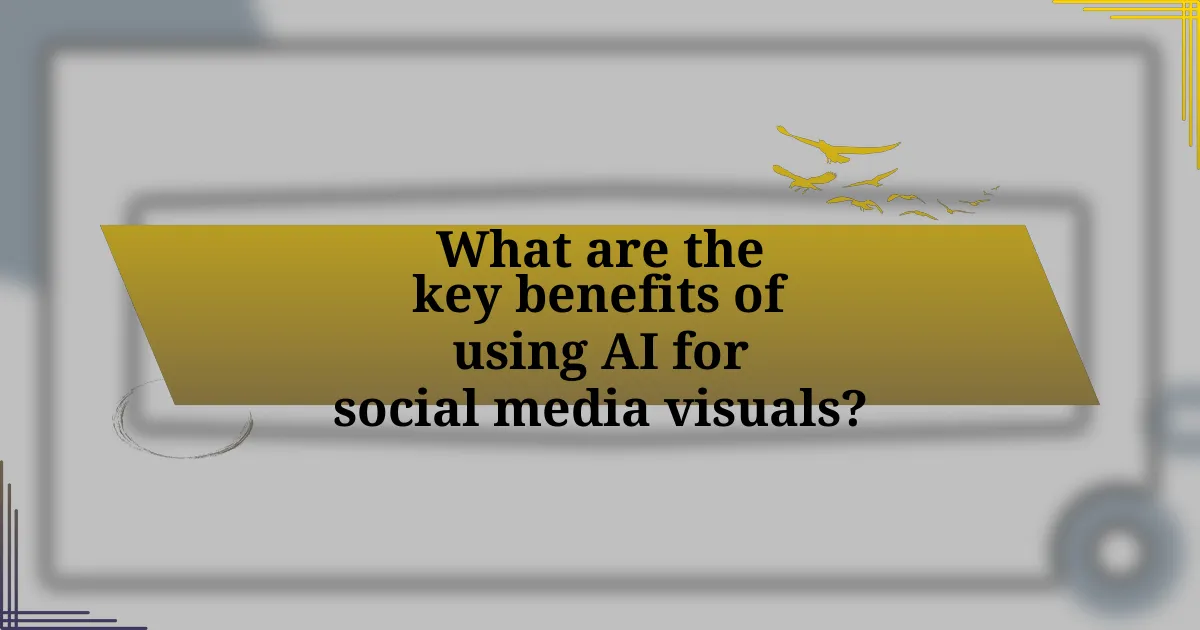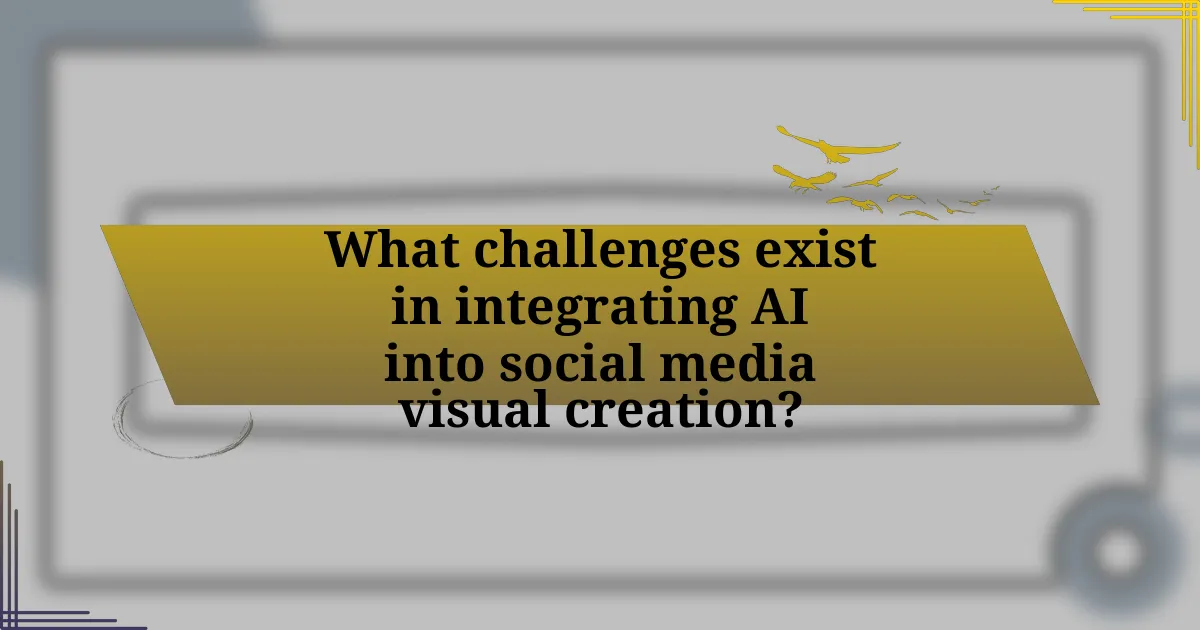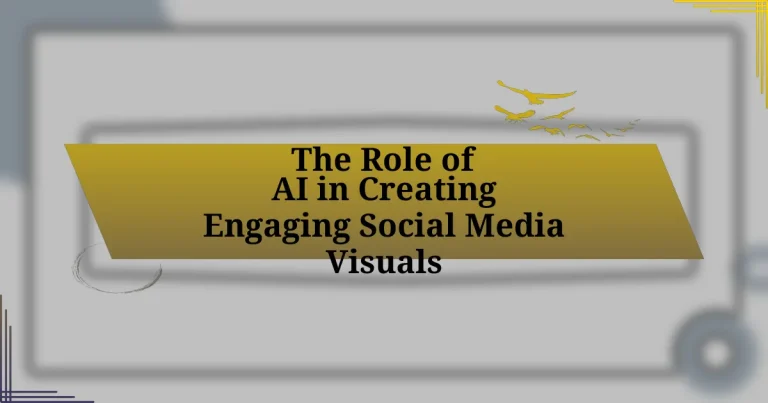The article examines the significant role of artificial intelligence (AI) in creating engaging social media visuals. It highlights how AI automates design processes, enhances creativity, and personalizes content to improve user engagement. Key technologies such as deep learning, computer vision, and generative adversarial networks (GANs) are discussed, along with the impact of visual content on audience retention and brand perception. The article also addresses the benefits and challenges of integrating AI into visual content creation, including ethical considerations and best practices for businesses to effectively implement AI tools.

What is the Role of AI in Creating Engaging Social Media Visuals?
AI plays a crucial role in creating engaging social media visuals by automating design processes and enhancing creativity. It enables users to generate high-quality images, videos, and graphics quickly, often using algorithms that analyze trends and audience preferences. For instance, tools like Canva and Adobe Spark utilize AI to suggest design elements and layouts tailored to specific demographics, improving user engagement. Research indicates that posts with visuals receive 94% more views than those without, highlighting the importance of effective visual content in social media strategies.
How does AI enhance the visual content creation process?
AI enhances the visual content creation process by automating design tasks, optimizing image quality, and personalizing content for target audiences. For instance, AI tools can generate graphics and layouts based on user preferences, significantly reducing the time required for manual design. Additionally, AI algorithms analyze engagement metrics to suggest design improvements, ensuring that visuals resonate with viewers. Research indicates that AI-driven platforms can increase content engagement rates by up to 50%, demonstrating their effectiveness in creating compelling visuals tailored to audience interests.
What technologies underpin AI’s role in visual content creation?
AI’s role in visual content creation is underpinned by technologies such as deep learning, computer vision, and generative adversarial networks (GANs). Deep learning algorithms enable AI to analyze and interpret visual data, allowing for the automatic generation and enhancement of images. Computer vision technology facilitates the understanding of images and videos, enabling tasks like object detection and image segmentation. GANs specifically contribute by generating new visual content through a process where two neural networks compete against each other, resulting in high-quality images. These technologies collectively enhance the efficiency and creativity of visual content production, making it more engaging for social media audiences.
How does AI analyze user engagement with visuals?
AI analyzes user engagement with visuals by employing algorithms that track and interpret user interactions, such as clicks, shares, and time spent on content. These algorithms utilize machine learning techniques to identify patterns in user behavior, allowing for the assessment of which visuals resonate most effectively with audiences. For instance, studies have shown that visuals with high contrast and vibrant colors tend to generate more engagement, as indicated by a 2019 report from HubSpot, which found that content with relevant images receives 94% more views than content without images. This data-driven approach enables AI to optimize visual content for better user engagement by continuously learning from user interactions and adapting strategies accordingly.
Why is engaging visual content important for social media?
Engaging visual content is important for social media because it significantly increases user interaction and retention. Research indicates that posts with visuals receive 94% more views than those without, highlighting the effectiveness of images and videos in capturing attention. Furthermore, engaging visuals can enhance brand recognition, as visuals are processed 60,000 times faster than text, making them a crucial element in conveying messages quickly and effectively. This combination of increased engagement and rapid information processing underscores the necessity of incorporating compelling visual content in social media strategies.
What impact does visual content have on audience retention?
Visual content significantly enhances audience retention by increasing engagement and memory recall. Studies show that people retain 65% of information when it is paired with relevant visuals, compared to only 10% when presented with text alone. This is supported by research from the Social Science Research Network, which indicates that visual aids can improve learning and retention rates by up to 400%. Therefore, incorporating visual elements in content not only captures attention but also facilitates better understanding and recall among audiences.
How does visual content influence brand perception?
Visual content significantly influences brand perception by enhancing emotional engagement and recall among consumers. Research indicates that visuals are processed 60,000 times faster than text, leading to quicker and more impactful brand associations. For instance, a study published in the Journal of Advertising Research found that ads with strong visual elements can increase brand recognition by up to 80%. This demonstrates that effective visual content not only captures attention but also shapes how consumers perceive and remember a brand, ultimately affecting their purchasing decisions.

What are the key benefits of using AI for social media visuals?
The key benefits of using AI for social media visuals include enhanced creativity, improved efficiency, and data-driven insights. AI tools can generate unique visual content quickly, allowing brands to maintain a consistent posting schedule without sacrificing quality. For instance, platforms like Canva and Adobe Spark utilize AI to suggest design elements and layouts, streamlining the creative process. Additionally, AI analyzes user engagement data to optimize visuals for target audiences, leading to higher interaction rates. According to a study by HubSpot, posts with visuals receive 94% more views than those without, highlighting the importance of effective visual content in social media strategy.
How does AI improve efficiency in content creation?
AI improves efficiency in content creation by automating repetitive tasks, enhancing creativity, and providing data-driven insights. Automation allows AI tools to generate text, images, and videos quickly, reducing the time required for manual content production. For instance, AI-driven platforms can create social media posts in seconds, enabling marketers to focus on strategy rather than execution. Additionally, AI enhances creativity by suggesting ideas and optimizing content based on audience preferences, which is supported by studies showing that AI-generated content can increase engagement rates by up to 30%. Furthermore, AI analyzes performance metrics to refine content strategies, ensuring that creators produce more effective and targeted materials.
What tools are available for AI-driven visual content creation?
AI-driven visual content creation tools include Canva, Adobe Spark, and DALL-E. Canva utilizes AI to enhance design capabilities, allowing users to create visually appealing graphics quickly. Adobe Spark offers AI features for generating videos and web pages, streamlining the creative process. DALL-E, developed by OpenAI, generates images from textual descriptions, showcasing the potential of AI in producing unique visual content. These tools exemplify how AI can facilitate and enhance the creation of engaging visuals for social media.
How does AI reduce the time spent on design tasks?
AI reduces the time spent on design tasks by automating repetitive processes and generating design elements quickly. For instance, AI tools can create layouts, suggest color schemes, and even produce graphics based on user input, significantly speeding up the design workflow. Research shows that AI-driven design platforms can cut project completion times by up to 50%, allowing designers to focus on more creative aspects rather than mundane tasks.
What advantages does AI offer in terms of personalization?
AI offers significant advantages in terms of personalization by enabling tailored content delivery based on user preferences and behaviors. This capability allows businesses to create highly relevant and engaging social media visuals that resonate with individual users. For instance, AI algorithms analyze user data, such as past interactions and demographic information, to recommend specific visual styles, colors, and themes that align with user interests. Research from McKinsey indicates that companies utilizing AI for personalization can achieve a 10-15% increase in sales, demonstrating the effectiveness of AI-driven personalization strategies in enhancing user engagement and satisfaction.
How does AI tailor visuals to specific audience segments?
AI tailors visuals to specific audience segments by analyzing data on user preferences, behaviors, and demographics to create personalized content. This process involves machine learning algorithms that identify patterns in engagement metrics, such as likes, shares, and comments, allowing AI to determine which visual elements resonate with different groups. For instance, a study by McKinsey & Company found that companies using AI for personalization can increase their marketing ROI by 15-20%, demonstrating the effectiveness of targeted visual strategies.
What role does data play in AI-driven personalization of visuals?
Data is essential in AI-driven personalization of visuals as it enables algorithms to analyze user preferences and behaviors. By leveraging large datasets, AI systems can identify patterns and trends that inform the customization of visual content, ensuring it resonates with individual users. For instance, platforms like Facebook and Instagram utilize user interaction data to tailor images and videos, enhancing engagement rates. Research indicates that personalized visuals can increase user interaction by up to 80%, demonstrating the significant impact of data on the effectiveness of visual personalization in social media contexts.

What challenges exist in integrating AI into social media visual creation?
Integrating AI into social media visual creation faces several challenges, including data privacy concerns, algorithmic bias, and the need for high-quality training data. Data privacy issues arise as AI systems often require access to user-generated content, which can conflict with privacy regulations like GDPR. Algorithmic bias can lead to the generation of visuals that reinforce stereotypes or exclude certain demographics, as AI models may reflect the biases present in their training datasets. Additionally, the effectiveness of AI in creating engaging visuals heavily relies on the availability of high-quality, diverse training data; without it, the AI may produce subpar or irrelevant content.
What are the potential drawbacks of relying on AI for visuals?
Relying on AI for visuals can lead to several potential drawbacks, including a lack of originality and the risk of perpetuating biases. AI-generated visuals often rely on existing datasets, which can result in repetitive or derivative content that lacks creativity. Additionally, if the training data contains biases, the AI may produce visuals that reinforce stereotypes or exclude certain demographics, leading to ethical concerns. For instance, a study by MIT Media Lab found that facial recognition systems exhibited higher error rates for individuals with darker skin tones, highlighting the risk of bias in AI-generated imagery.
How can AI-generated content lack authenticity?
AI-generated content can lack authenticity due to its reliance on algorithms and data patterns rather than genuine human experience or emotion. This content often mimics existing styles and themes without the unique insights or personal touch that characterize authentic human expression. For instance, a study by the Pew Research Center indicates that audiences can discern between human and AI-generated content, often perceiving the latter as less relatable and emotionally resonant. Consequently, the absence of personal narratives and emotional depth in AI-generated content contributes to its perceived lack of authenticity.
What ethical considerations arise from using AI in visual content?
The ethical considerations arising from using AI in visual content include issues of copyright, misinformation, and bias. Copyright concerns emerge when AI-generated visuals may inadvertently replicate existing works, leading to potential infringement. Misinformation can occur when AI creates misleading or manipulated images that distort reality, impacting public perception and trust. Additionally, bias in AI algorithms can result in the perpetuation of stereotypes or exclusion of certain groups, as seen in studies indicating that AI systems often reflect the biases present in their training data. These considerations highlight the need for responsible AI usage in visual content creation.
How can businesses effectively implement AI for social media visuals?
Businesses can effectively implement AI for social media visuals by utilizing AI-driven design tools that automate the creation of graphics and videos tailored to target audiences. These tools analyze user engagement data to generate visually appealing content that resonates with specific demographics, enhancing overall engagement. For instance, platforms like Canva and Adobe Spark leverage AI to suggest design elements based on current trends and user preferences, allowing businesses to produce high-quality visuals quickly and efficiently. Additionally, AI can optimize posting times and formats by analyzing past performance metrics, ensuring that visuals reach the audience when they are most active. This data-driven approach not only streamlines the content creation process but also increases the likelihood of higher engagement rates, as evidenced by studies showing that posts with compelling visuals receive 94% more views than those without.
What best practices should be followed when using AI tools?
When using AI tools, best practices include ensuring data privacy, validating AI-generated content, and maintaining human oversight. Data privacy is crucial as it protects user information and complies with regulations like GDPR. Validating AI-generated content ensures accuracy and relevance, as studies show that AI can produce errors or biased outputs. Maintaining human oversight is essential to guide AI tools effectively, as human judgment can enhance creativity and contextual understanding, leading to more engaging social media visuals.
How can companies measure the success of AI-generated visuals?
Companies can measure the success of AI-generated visuals through key performance indicators (KPIs) such as engagement rates, conversion rates, and audience reach. Engagement rates can be assessed by analyzing likes, shares, comments, and overall interaction with the visuals on social media platforms. Conversion rates indicate how effectively the visuals drive desired actions, such as purchases or sign-ups, providing a direct measure of impact. Audience reach can be evaluated by tracking impressions and the number of unique users who view the visuals, which helps gauge the overall visibility and effectiveness of the content. These metrics provide concrete data that validate the effectiveness of AI-generated visuals in achieving marketing objectives.
What tips can enhance the effectiveness of AI in creating engaging visuals?
To enhance the effectiveness of AI in creating engaging visuals, it is essential to utilize high-quality datasets for training AI models. High-quality datasets ensure that the AI can learn from diverse and representative examples, leading to more accurate and appealing visual outputs. For instance, a study by Karras et al. (2019) demonstrated that using extensive and varied datasets significantly improved the realism of generated images in their GAN-based model. Additionally, incorporating user feedback into the AI’s learning process can refine its ability to create visuals that resonate with target audiences, as evidenced by research indicating that iterative design processes involving user input lead to higher engagement rates.

